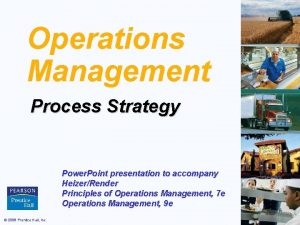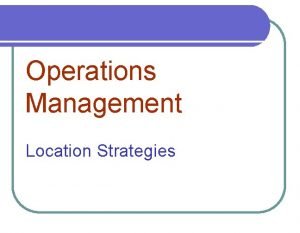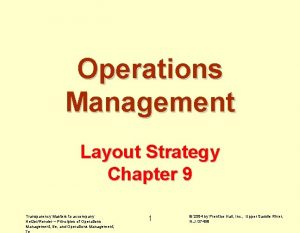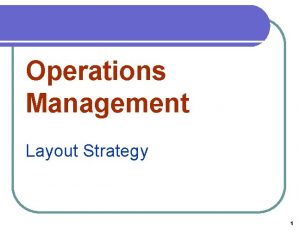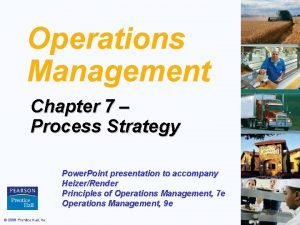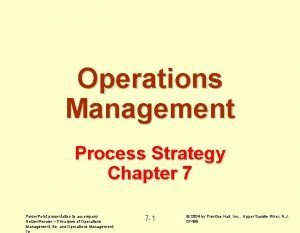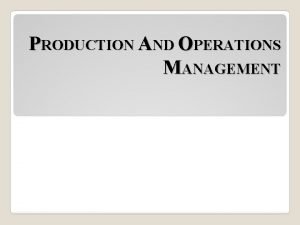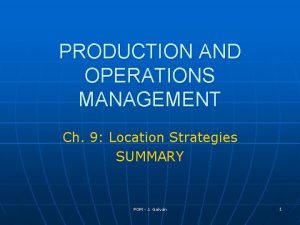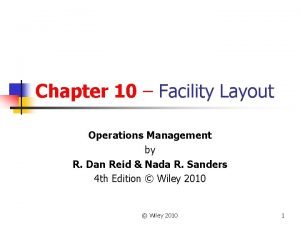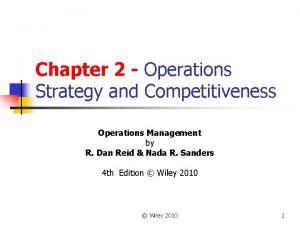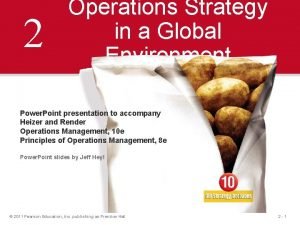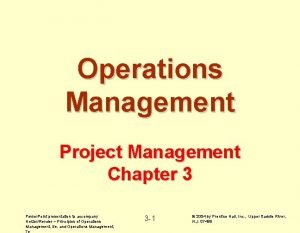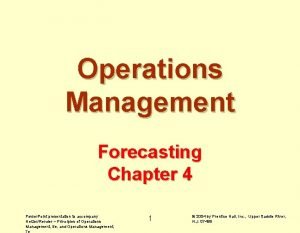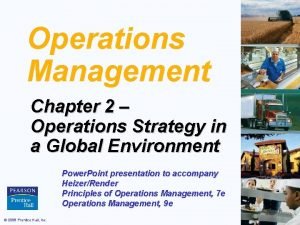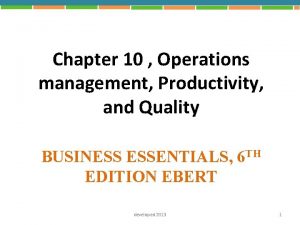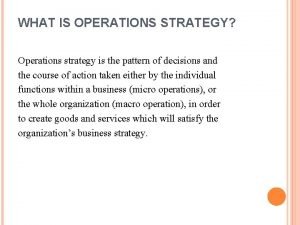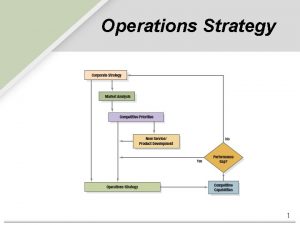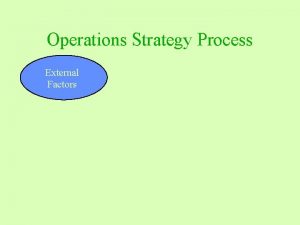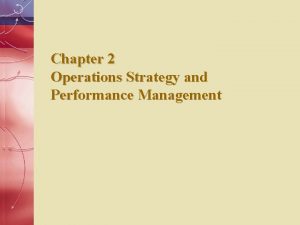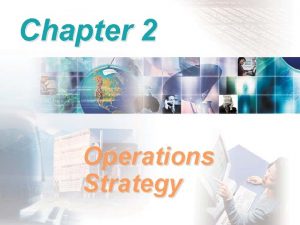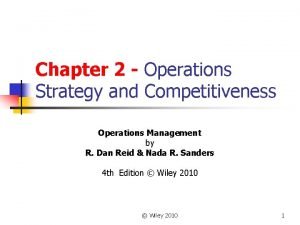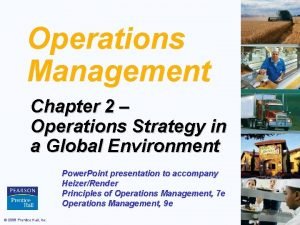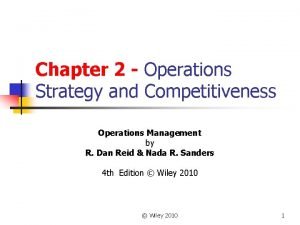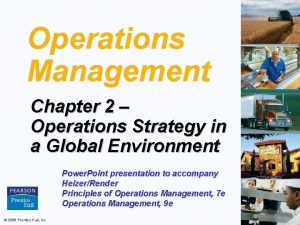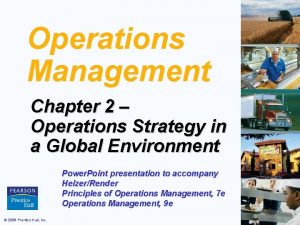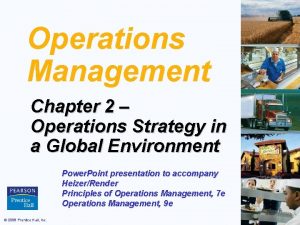Chapter 2 Operations Strategy Operations Management 6 th






















- Slides: 22

Chapter 2 Operations Strategy Operations Management - 6 th Edition Roberta Russell & Bernard W. Taylor, III Copyright 2006 John Wiley & Sons, Inc. Beni Asllani University of Tennessee at Chattanooga

Operations Strategy w A vision that unites an organization, provides consistency in decision, and keep the organization moving in the right direction. There are five basic steps that consists the strategy w w w Defining a primary Task Assessing core competencies Determining order winner and order qualifier Positioning the firm Deploying the strategy Copyright 2006 John Wiley & Sons, Inc. 1 -2

Operations Strategy w Defining a primary Task w Represent the purpose of a firmwhat the firm is in business of doing w Determine the competitive arena Copyright 2006 John Wiley & Sons, Inc. 1 -3

Operations Strategy w Assessing core competencies w What a firm does better than anyone else. It includes the issues; w Exceptional services, higher quality, faster delivery, lower cost Copyright 2006 John Wiley & Sons, Inc. 1 -4

Operations Strategy w Determining order winner and order qualifier Copyright 2006 John Wiley & Sons, Inc. w Order qualifier: The characteristics of a product or service that qualify it to be considered for purchase by a customer w Order winner-The characteristics of a product or service that wins orders in the marketplace- the final factor in the purchasing decision. 1 -5

Operations Strategy w Positioning w How it will compete in the marketplace – what unique value it the firm will deliver to the customer w It considers the strengths and weaknesses of the organization, the needs of the marketplace, and the position of competitors. w A company that has positioned itself to compete on cost, quality, flexibility and speed Copyright 2006 John Wiley & Sons, Inc. 1 -6

Positioning the firm w Competing on cost w Companies that compete successfully on cost realize that low cost cannot be sustained as a competitive advantage if increases in productivity are obtained solely by short-term cost reductions Copyright 2006 John Wiley & Sons, Inc. 1 -7

Positioning the firm w Competing on quality w Quality is confined to minimizing defect rates or conforming to design specifications w To compete on quality, company must view it as an opportunity to please the customer, not just a way to avoid problems or reduce rework cost. Copyright 2006 John Wiley & Sons, Inc. 1 -8

Positioning the firm w Competing on flexibility w Flexibility is the ability to adjust to changes in product mix, production volume, or design w It includes the ability to produce a wide variety of products, to introduce new products and modify existing ones quickly and to respond to customer needs. Copyright 2006 John Wiley & Sons, Inc. 1 -9

Positioning the firm w Competing on speed w an organization characterized by fast moves, fast adaptations and tight linkages Copyright 2006 John Wiley & Sons, Inc. 1 -10

Operations Strategy w Deploying the strategy w Implementing strategy can be more difficult than formulating strategy. w Different departments or functional areas in a firm may interpret the same strategy in different ways. w If their efforts are not coordinate, the results can be disastrous Copyright 2006 John Wiley & Sons, Inc. 1 -11

Effective ways to deploy strategy w The strategic planning Hierarchy w A corporate strategic plan in concurrence with the firm’s mission and vision, customer requirements and business conditions. w The strategic plan focuses on the gap between the firm’s vision and its current position w It identifies what needs to be done to close the gap and provides direction formulating strategies in the functional areas of the firm such as marketing, operations and finance Copyright 2006 John Wiley & Sons, Inc. 1 -12

Effective ways to deploy strategy w Focus everyone in an organization w Policy on common goals and priorities by Deploymen translating corporate strategy into t measurable objectives throughout the various functions and levels of the organization w Everyone in the organization should understand the strategic plan, be able to drive several goals from the plan and determine how each goals tie into their own daily activities Copyright 2006 John Wiley & Sons, Inc. 1 -13

Effective ways to deploy strategy w Balanced Scorecar d w Balanced scorecard measuring more than financial performance, which examined a firm’s performance in four critical areas w Finance: How should we look to our shareholders? w Customer: How should we look to our customers? w Processes: At which business processes must be excelling? w Learning and Growing: How will we sustain our ability to change and improve? Copyright 2006 John Wiley & Sons, Inc. 1 -14

Strategic Decisions in Operations w w w w Strategic decisions in operations involve Products and service processes and technology capacity and facilities human resources Quality Sourcing Operating systems Copyright 2006 John Wiley & Sons, Inc. 1 -15

Strategic Decisions in Operations w Product and Services w The kinds of products and services offered by a company drive operations strategy. Products and services can be classified as make-to-order, make- to- stock or assembleto-order. w Make-to-order w Make –to- stock w Assemble-to-order Copyright 2006 John Wiley & Sons, Inc. 1 -16

Strategic Decisions in Operations w Process and Technology w Production process can be classified into w Projects w Batch production w Mass production w Continuous production Copyright 2006 John Wiley & Sons, Inc. 1 -17

Strategic Decisions in Operations w Capacity and Facilities w Capacity decisions affect product lead times, customer responsiveness, operating costs and a firm’s ability to compete w Inadequate capacity can lose customers and limit growth w Excess capacity can drain a company’s resources and prevent investments in more lucrative ventures w When, how much and in what form to alter capacity are critical decisions Copyright 2006 John Wiley & Sons, Inc. 1 -18

Strategic Decisions in Operations w Human Decisions w Strategic issues in human resources involve w determining the skill levels and degree of autonomy required to operate the production system w outlining training requirements and selection criteria w setting up policies on performance evaluations w compensation and incentives Copyright 2006 John Wiley & Sons, Inc. 1 -19

Strategic Decisions in Operations w Quality permeates virtually every w w w strategic decision What is the target level of quality for our products and services? How will it be measured? How will employee be involved with quality? What types of training are necessary? How will customer perceptions of quality be determined? Copyright 2006 John Wiley & Sons, Inc. 1 -20

Strategic Decisions in Operations w Sourcing w On what basis should particular items be made-inhouse? When should items be out sourced? w A firm that sells the product, assembles the product, makes all parts and extracts the raw material is completely vertically integrated w But most companies cannot or will not make all of the parts that go into a product w A major strategic decision, then, is how much of the work should be done outside the firm Copyright 2006 John Wiley & Sons, Inc. 1 -21

Strategic Decisions in Operations w Operating Systems w Operating systems execute strategic decisions on a day to day basis, so it is important that they be designed to support how the firm competes in the market place w The IT system must be able to support both customer and worker demands for rapid access, storage and retrieval of information w Planning and control systems must be set up with timely feedback loops and consistent decision making criteria w Inventory levels, scheduling priorities and reward systems should align with strategic goals. Copyright 2006 John Wiley & Sons, Inc. 1 -22
 Chapter 12 inventory management
Chapter 12 inventory management Process strategy operations management
Process strategy operations management Objective of location strategy
Objective of location strategy Layout strategies in operations management
Layout strategies in operations management Seven layout strategies
Seven layout strategies Process strategy operations management
Process strategy operations management Operations management process strategy
Operations management process strategy Location strategy case study
Location strategy case study Location strategy in operations management
Location strategy in operations management Four process strategies in operations management
Four process strategies in operations management Layout strategy in operations management
Layout strategy in operations management Operations strategy and competitiveness
Operations strategy and competitiveness Chapter 2 operations strategy and competitiveness
Chapter 2 operations strategy and competitiveness Operations strategy in a global environment
Operations strategy in a global environment Quality management in operations management
Quality management in operations management Operations management with total quality management book
Operations management with total quality management book Operations management chapter 3 solutions
Operations management chapter 3 solutions Operations management chapter 4 forecasting solutions
Operations management chapter 4 forecasting solutions Chapter 2 operations management
Chapter 2 operations management Role of operations management
Role of operations management Process selection operations management
Process selection operations management Operations management chapter 10
Operations management chapter 10 Asq control chart
Asq control chart

